Antique Vintage Sterling Coin Silver Native Navajo Pawn Turquoise Cuff Bracelet
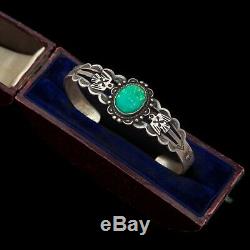
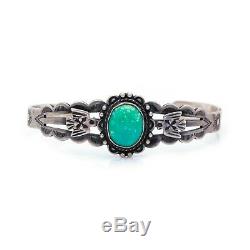
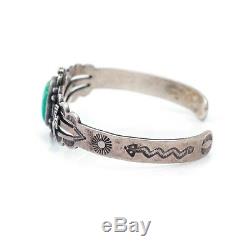
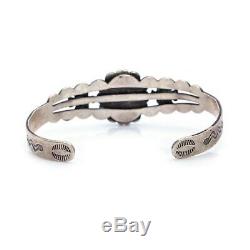
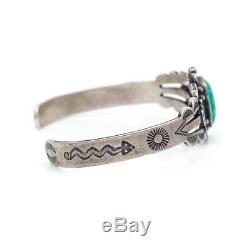
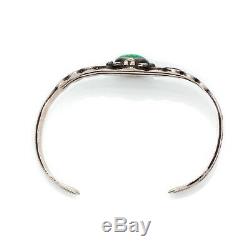
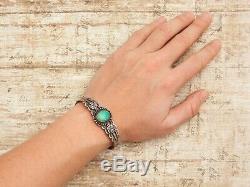

We have similar Native and Turquoise items, which would pair nicely with this piece, for sale this week. Listing Description by: Dylan L. Age Circa: Antique Native American C. Country of Origin: United States - Navajo Nation.
Gram Weight: 16.6 Grams. Main Stone Measurements/Color : Measures 12.3 mm long by 10 mm wide, Opaque bright blue-green hue with some white striations. Stone Treatment : The stone(s) appear to be untreated, but we are not certified gemologists. Stone(s) have been tested and guaranteed using a professional Presidium Duo refractive, heat, and hardness tester.
Stone Cuts : Oval Cabochon Cut. Item Measurements: The bracelet has a wearable length and inner circumference of up to 6.25 long including the wrist gap.
The bracelet measures 0.76. In width at the widest part. 900 Coin Sterling Silver Bands.The base of the bezel setting is surrounded with a rope twist accent as well as applied granulation and scalloped portions. Surrounding the face of the cuff is hand stamped Navajo stampings. These are in the motif of a Thunderbird, which symbolizes power and courage. There is also a rain motif, which symbolizes plentiful crops.
There is also a teepee motif, which symbolizes home, a sunburst motif, which symbolizes consistency, and a lightning snake, which symbolizes lightning. This item is ever so slightly tarnished in some areas, which serves to add to the overall look of this item. The price of this item has been reduced to reflect this.This listing is for the item only. This beautiful piece was made by a very talented Native American silversmith. It features handcrafted silversmith work throughout.
Antique Native American jewelry is very rare to find. This is due to these pieces being made for reservation and personal use before the tourist trade became popular. Very few pieces were made and even less survived to today.
The concept of Pawn, Old Pawn, and Dead Pawn Native American Jewelry came to be in the 1800s. When a loan wasnt repaid, the item became known as either Old Pawn or Dead Pawn. The Navajo Nation sits on 27,000 square miles within the states of Arizona, New Mexico, and Utah.The Navajo have a rich history and culture and have become known for creating some of the finest sterling silver and turquoise jewelry, incorporating their own traditional motifs with silversmithing. The squash blossom necklace is perhaps one the most famous Navajo styles produced, along with turquoise inlay rings. Turquoise is an important stone in Navajo culture; symbolizing happiness, good fortune, and good health. The first Navajo silversmith, Atsidi Sani, was taught around 1865 by a Mexican silversmith.
Atsidi Sani, in turn, taught his four sons, who then started teaching other Navajo artisans. In the beginning, Navajo artisans created sterling silver jewelry for themselves and others in the Navajo Nation. Navajo silversmiths, working from 1870 to 1900, learned about stamping from Mexican leather workers, and adopted this to their metal working.
Artisans made their own stamps that were passed down to each generation. Stampings are usually hand hammered using handcrafted or die stamps and include traditional Native American symbols, such as sunbursts, to ornate landscapes. This technique has been passed on and utilized by other Native American tribes and continues to be a popular method of jewelry making. Pre 1950s Navajo silversmiths would make jewelry out of US 90% Silver coins.
They would use Half Dollars, Quarters, & Mercury Dimes. This type of jewelry is very rare, as it usually contained a high silver purity and was expensive to make.
Whole Coin jewelry was worn around the reservation as a status symbol of wealth. Buyers will have 3 base. The item "Antique Vintage Sterling Coin Silver Native Navajo Pawn Turquoise Cuff Bracelet" is in sale since Sunday, March 10, 2019. This item is in the category "Jewelry & Watches\Ethnic, Regional & Tribal\Native American\Bracelets".
The seller is "abeautifultimeco" and is located in Fort Collins, Colorado. This item can be shipped worldwide.- Style: Cuff
- Modified Item: No
- Country/Region of Manufacture: United States
- Metal: Sterling Silver
- Jewelry Type: Bracelets
- Tribal Affiliation: Navajo
- Main Stone: Turquoise
- Ethnic Origin: Navajo
- Metal Purity: .

